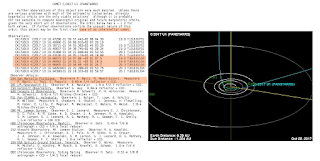C/2017 U1 (PANSTARRS) Cometa interstellare ?
- Dettagli
- Visite: 5689
C/2017 U1 (PANSTARRS) interstellar comet
La notte del 18/10/2017 il telescopio F51 Pan-STARRS 1, Haleakala. scopre un nuovo oggetto celeste. Inserito tra gli oggetti della pagina del Minor Planet Center NEOCP con la sigla provvisoria P10Ee5V.
Dall'osservatorio di 104 San Marcello Paolo Bacci e Martina Maestripieri la sera del 19/10/2017 CONFERMANO il corpo celeste, cioè siamo i primi ad averlo ritrovato dopo gli scopritori.
Il25/10/2017 alle ore 03:53 UT esce la circolare MPEC 2017-U181: COMET C/2017 U1 (PANSTARRS), con la quale viene annunciata la scoperta della Cometa C/2017 U1.
Questa MPEC è davvero insolita in quanto riporta un avviso:
"Further observations of this object are very much desired. Unless there are serious problems with much of the astrometry listed below, strongly hyperbolic orbits are the only viable solutions. Although it is probably not too sensible to compute meaningful original and future barycentric orbits, given the very short arc of observations, the orbit below has e ~ 1.2 for both values. If further observations confirm the unusual nature of this orbit, this object may be the first clear case of an interstellar comet."
Potrebbe trattarsi del primo caso di cometa interstellare, ovvero di una cometa non appartenete al nostro sistema solare, con un orbita, se confermata, iperbolica.
Orbital elements:
C/2017 U1 (PANSTARRS)
Epoch 2017 Sept. 4.0 TT = JDT 2458000.5
T 2017 Sept. 9.41719 TT MPCW
q 0.2515404 (2000.0) P Q
z -0.7541603 Peri. 241.01670 -0.63536548 +0.68733697
+/-0.0181483 Node 24.61531 +0.49903801 +0.71329677
e 1.1897018 Incl. 122.32770 -0.58929769 -0.13702411
From 34 observations 2017 Oct. 18-24, mean residual 0".5.
Per noi è davvero una grande soddisfazione aver partecipato attivamente a questa importante scoperta che, se verrà confermata, sarà il primo oggetto scoperto proveniente dall'esterno del sistema solare.
Adesso ci metteremo a lavoro e continueremo ad osservare questo debole oggetto che ha una luminosità di 20 mag.
Incrociamo le dita, potremmo entrare nella storia :-)
Letture consigliate:
- Albino Carbognani : C/2017 U1 è una cometa interstellare?
- Wikipedia




